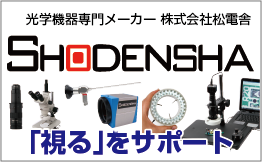Pixel density in a bitmap image refers to the numerical representation of the granularity of the grid that expresses the image, indicating how many divisions there are in one inch.
In the case of a microscope, each of the camera, lens, and monitor has its own resolution.
1. Camera and lens resolution
Camera and lens resolution refers to the granularity of the grid that expresses the image.
It is a term that represents the detailing capability for subjects (such as screens, print results, photographic films, etc.) where the physical size of the image can be defined.
Therefore, physical resolution expresses the ability to distinguish the smallest unit of that image (pixels on a screen, resolution lines/spaces on print results or photographic film) per unit length of the subject, and it represents the level of detail rather than just the total count.
When selecting a microscope, especially the resolution of the camera and lens is crucial. For instance, if the camera has high resolution but the lens has low resolution, the resulting image will have poor resolution. Therefore, please be mindful of this aspect when choosing a microscope.
2. Monitor resolution
Monitor resolution refers to the ‘total number of pixels used for display,’ such as 1024×768.
XGA: 1024×768 pixels
SXGA: 1280×1024 pixels
VGA: 640×480 pixels
|
Description
|
Resolution
|
Monitor ratio |
|
VGA |
640×480 |
4:3 |
|
SVGA |
800×600 |
4:3 |
|
XGA |
1024×768 |
4:3 |
|
WXGA |
1280×768 |
15:9 |
|
WXGA |
1280×800 |
16:10 |
|
SXGA |
1280×1024 |
5:4 |
|
UXGA |
1600×1200 |
4:3 |
|
FHD (Full-HD, 1080p) |
1920×1080 |
16:9 |
If you are using our PC Monitor Direct Microscope, Video Microscope, and High-Definition Microscope, the monitor aspect ratio is crucial.
For the PC Monitor Direct Microscope TG80XGA3 and all Video Microscope models, please use a monitor with a 4:3 aspect ratio or a widescreen monitor that can switch to a 4:3 aspect ratio.
For the High-Definition Microscope, use a monitor with Full High-Definition support (1080p) and for the 4K Microscope, use a monitor with 4K support and a 16:9 aspect ratio, or the displayed images may not have the correct proportions.
For USB microscopes, you can use them regardless of the monitor’s resolution. The USB camera’s image sensor has a 4:3 aspect ratio, so even if the PC screen has a different aspect ratio, the image within the launched application will be in a 4:3 format.



